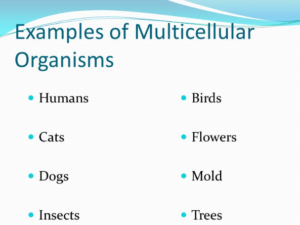Multicellular Organisms Examples

Living beings (organisms), depending on the number of cells that compose them, can be considered unicellular (if they are made up of a single cell) or multicellular (or multicellular, which is made up of two or more cells). Common examples of multicellular organisms are dolphins, chickens, wheat, grass.
Cells are considered the smallest units of life. They are units both in morphological and functional aspects. They are morphological units because they are surrounded by an envelope, called the cell or cytoplasmic membrane.
Furthermore, cells are functional units because they constitute a complex biochemical system. As such, they have the ability to nourish themselves and maintain their own metabolism, grow and multiply from the genetic material they contain in the nucleus, differentiate (develop specific characteristics different from those of other cells), and evolve.
All the characteristics of cells are shared by unicellular and multicellular (also called multicellular ) organisms.
See also: Cellular organelles
Multicellular organisms initially arise from a single cell. Even human beings at the moment of conception are initially a cell. However, that cell immediately begins to multiply. Cells can reproduce through two processes:
- Mitosis. It occurs in somatic cells. The cell divides only once (two cells come out of one cell). Sister chromatids separate and crossing over does not occur, so the two daughter cells have the same genetic information. It is a short cell division that has as its objective the growth and renewal of cells and tissues.
- Meiosis. It is produced only in the stem cells of the gametes (sex cells). The cell divides twice. In the first division, homologous chromosomes separate, in the second, chromatids separate, and then there is a crossing over between homologous chromosomes. That is why the four daughter cells are genetically different. Its objective is the continuity of the species and genetic variability.
Examples of multicellular organisms
- The human being. The different types of cells form the multiplicity of tissues that in turn form the circulatory, nervous, bone, etc. systems.
- crab. Like other crustaceans, part of its cells is differentiated to form an exoskeleton, a structure that covers and protects the animal.
- Dolphin. aquatic mammal. Like all animals, it is made up of various types of animal eukaryotic cells.
- wheat. Cereal of the grass family. It is made up of various types of plant eukaryotic cells.
- swallow. Bird of migratory habits, belonging to the family of the hirundinids, of the order of the passerines.
- lawn. Like other monocotyledonous plants, its stem includes meristematic cells that increase its length after being cut.
- hen. Bird of the Phasianidae family. Like other birds, it is covered in feathers made up of specialized cells in the epidermis called keratinocytes.
- Salmon. Both marine and freshwater fish. Like most fish (bony or cartilaginous) its skin is covered with scales, specialized cells different from the scales of reptiles.
- temporary frog. Anuran amphibian of the Ranidae family inhabits Europe and northwestern Asia.
- Green lizard. Species of lizard (reptile) of the Teiidae family. It is located in an ecozone that extends through the Argentine, Bolivian and Paraguayan Chaco.
Of course, in addition to those mentioned, thousands of examples could be listed, since all the animals that exist are multicellular organisms. If you need more examples, you could visit the section on vertebrate animals or invertebrate animals.
Related Articles: